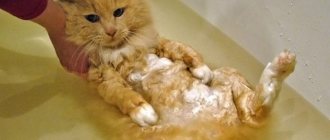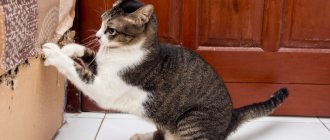Surgery that involves removing reproductive function in cats is called sterilization.
It is carried out for medical reasons, or in the absence of the owner’s desire to receive kittens from the pet, and also to endure periods of estrus.
Sterilization of a pregnant cat is a special issue. Experts in the field of veterinary medicine strongly recommend sterilizing your pet before the onset of the first heat.
If the beginning of the first heat is missed, you need to wait until it ends, and only then perform the operation. During the period of sexual heat, it is important that the animal does not become pregnant.
In what cases is a pregnant cat sterilized?
Veterinarians decide to spay or neuter a pregnant cat in emergency cases. During gestation, the body is under the influence of hormonal changes and is weakened. The operation entails negative consequences that threaten life.
It is important to examine the animal before surgery. Diagnostics minimizes postoperative risks.
Castration of a cat bearing kittens is called a hysterectomy procedure. It is carried out if there are medical indications, which are:
- developmental abnormalities of kittens;
- congenital deformities of fetuses;
- pregnancy fading;
- advanced age of the cat;
- infectious diseases that are treated with powerful and toxic antibiotics or antifungals;
- aggressive neoplasms;
- the appearance of pathologies during pregnancy;
- risk of oncology of internal reproductive organs;
- the likelihood of pyometra.
If there are no medical indications, veterinarians advise allowing the cat to give birth and then performing an oophorectomy or ovariohysterectomy.
Problems that sterilization solves
Sterilization will help save owners and their pets from many problems.
- The purr will no longer bother the owner with various behavioral problems associated with the search for a potential partner.
- With this step, the owners make a small, but still significant contribution to controlling the birth rate and the number of animals that are deprived of their homes.
- Domestic cats will almost certainly become infected with some kind of infectious disease by having sexual contact with stray animals. By controlling the birth rate, owners also control the risk of their pets contracting infectious diseases.
Risks of sterilization during pregnancy
Spaying or neutering a pregnant cat means aborting it, which involves removing the internal genitalia. Even experienced veterinary surgeons cannot preserve the integrity of the endometrium when removing embryos. This is fraught with infection and inflammation.
Risks to a pet’s health are determined by the characteristics of its physiology. The cat's uterus is bicornuate and has a large extent. It holds several fruits and grows. This complicates the operation.
Sterilizing pregnant cats carries risks such as:
- Blood loss. The uterus is permeated with vessels that nourish the placenta and fetuses. The slightest damage to an organ may cause bleeding.
- Long cut and large seam. This is due to the enlargement of the uterus and its length.
- Long rehabilitation period. Due to the traumatic nature of the operation, the cat will take a long time to recover.
After sterilization of a pregnant pet, sex hormones (estrogens) do not immediately cease to be produced. Owners should be prepared for the fact that for some time after the removal of the uterus and ovaries the cat may ask for a cat. This will pass after 1-2 months.
Pros and cons of sterilizing a pregnant cat
Having made a choice in favor of sterilizing a cat, the owner may be faced with both pros and cons. So, after castration, the cat will become more docile, aggression will disappear and the cat will not have a constant desire to run away from home. The disadvantages are possible complications, such as bleeding or inflammation in the pelvic area if improper manipulation is carried out. By following all the rules of antisepsis and asepsis, as well as providing proper care for your pet, complications can be avoided.
In addition, after sterilization, the cat needs to change and select its diet. This is due to the fact that an animal after surgery to remove reproductive organs tends to gain weight, which leads to disturbances in the functioning of the urinary and cardiovascular systems.
Possible complications
The owner of the animal is often afraid of complications that may arise as a result of surgery. This is fine. However, if there are medical conditions, surgery must still be performed. Otherwise, the cat may die.
Veterinarians list the following possible complications after extirpation of the uterus with fetuses:
- Behavioral problems. At the subconscious level, the cat understands that it is pregnant. After the removal of the internal genital organs along with the embryos, she experiences stress, which even leads to depression.
- Sepsis. Blood poisoning is possible if there were dead fetuses in the uterus. Their breakdown products provoke acute inflammation.
- Intra-abdominal bleeding. If during an operation the surgeon accidentally damages the uterus, the cat may bleed to death in a matter of minutes and it will be extremely difficult to help.
- Peritonitis. This is an infectious inflammation of the peritoneum that can lead to death. It develops when sanitary and hygienic standards are not observed during surgery, and pathogenic microbes and bacteria enter the abdominal cavity.
- Incorrectly calculated dose of anesthesia. It is difficult for a pregnant cat to choose an anesthetic drug. If the dose is calculated incorrectly, the animal runs the risk of waking up prematurely or not recovering from anesthesia at the end of the operation.
- Inflammation of the sutures. During extirpation, a long incision is made and it heals slowly. During the rehabilitation period, it may become infected. Against this background, inflammation appears.
Sometimes females after such operations develop hormonal disorders and aspiration pneumonia.
The decision about whether a cat can be sterilized during pregnancy is made by the doctor. After castration or sterilization, it is recommended to leave the pet for some time in a veterinary clinic under the supervision of a doctor.
Postoperative care
It is important for the owner to take care of the safety of his pet after surgery, since while under the influence of narcotic substances, the cat may not control its movements and cause harm to itself. It is recommended to transport the operated animal in a special carrier. During the period of recovery from anesthesia, the cat's pulse and breathing slow down significantly, and the body temperature also decreases. There is a risk of cat hypothermia, and if it is cold outside, it is recommended to cover the pet with a warm blanket and place a heating pad under its back.
Note! While in a narcotic sleep, cats' eyes do not close and there is a high risk of developing inflammatory processes in the cornea of the eye. In order to avoid such complications, it is necessary to close and open the cat’s eyes several times over the course of an hour.
After the cat has completely recovered from anesthesia, it is necessary to offer the cat a small amount of water, as the thirst will be very strong. You can give your cat small portions of food after a few hours. But in most cases, the animal has no appetite and this is a variant of the norm.
Timing of sterilization during pregnancy
It is recommended to do the operation as early as possible. Owners need to know when it is no longer possible and until what point it is still possible to sterilize a pregnant cat. This will protect their pet from the negative consequences of surgery.
In early pregnancy
It is better to carry out the operation for a period of no more than 3 weeks. It is also more humane in relation to fetuses that have not yet had time to form into full-fledged kittens.
In addition, in the early stages of pregnancy (up to 6 weeks), the risk of postoperative complications is low.
Late sterilization
It happens that a pet has free access to the street. The owner cannot accurately determine the time of conception and gestational age. Therefore, if there are medical indications, the operation is performed.
If there is no reason for hysterectomy for a long period (more than 6 weeks), the operation is not performed.
How will the cat behave after surgery?
Typically, cat owners, especially beginners, are interested in how the animal will behave after sterilization. The fact is that the operation itself lasts no more than 15 minutes, but as a result, the animal will lose the ability to bear offspring.
Attention! In order for the cat to recover well and behave the same way as before the operation, it is necessary, if she gave birth and is nursing kittens, to wait until they are weaned.
This is due to the fact that it is necessary to wait until the animal’s mammary glands return to normal. Normally this occurs within 2-3 weeks. Only after this can the animal be sterilized. If the operation is performed earlier, this will negatively affect the cat’s health.
A cat can be sterilized only after its mammary glands return to normal.
One of the concerns that cat owners usually express is the fear that the animal may suddenly gain weight after surgery. To prevent this from happening, it will be necessary to limit the animal’s diet and feed it strictly according to a schedule. In this case, it is necessary to use low-calorie feed for feeding. If you follow these rules, your cat will not get fat.
We should also talk about the effect of sterilization on the animal’s instincts. So, for example, many cat owners fear that a sterilized animal will stop catching mice. This is usually associated with the fact that hormones exacerbate the hunting instinct, and when the ovaries are cut out, they are produced in small quantities, and the cat stops catching mice. It is a myth. The hunting instinct is innate and has nothing to do with the possibility of procreation, so if your cat was great at catching mice before surgery, she will do it great after it.
It’s worth dispelling another myth. It consists in the fact that sterilized animals do not mark. There is some truth in this statement, since such a cat has less need to mark its territory, and education plays a big role here. If you have not taught the animal to be clean from the very beginning, no amount of surgery will help you do this. Therefore, even at a tender age, teach the kitten to go to the litter box on time. This will give you greater effect than any other surgery.
With the help of sterilization you will extend the life of the animal by 2-3 years
In any case, remember that if you want to have offspring from your cat, it is better to give her medications that suppress sexual desire from time to time, since sterilization surgery is irreversible. As for those animals that are of no value in the tribal sphere, they should definitely be operated on, since this will not only get rid of various inconveniences, but will also extend the life of your animal by 2-3 years.
Features of caring for an operated animal
Castration while carrying kittens comes with a lot of risks. To prevent negative consequences, the cat must be properly cared for in the postoperative period.
Care includes:
- putting on a blanket or bandage;
- regular change of dressings;
- treating seams with peroxide or brilliant green;
- examination and careful palpation of the abdomen;
- feeding with medicinal canned food;
- ensuring physical and psychological peace;
- arrangement of a soft sleeping place at floor level.
The health of the pet depends on the professionalism of the veterinary surgeon and the care of the owner. After experiencing stress, a cat may behave distantly for some time. This will pass. However, if more dangerous symptoms occur (fever, refusal to eat, lethargy), you should consult a doctor.
All information posted on the site is provided in accordance with the User Agreement and is not a direct instruction to action. We strongly recommend that before using any product, you must obtain a face-to-face consultation at an accredited veterinary clinic.
Rehabilitation period
How quickly does recovery occur after an operation such as sterilization of a pregnant cat? The consequences, depending on the condition of the animal and the presence of serious chronic diseases, may be different. Accordingly, the rehabilitation time varies.
Particular attention should be paid to the following symptoms:
- Lack of appetite for three days after surgery.
- Temperature rises to 39.5 3-5 days after extraction.
- The appearance of swelling in the area of sutures.
- Discharge of pus, appearance of an unpleasant odor from the wound.
- Lethargy and apathy of the animal.
If these signs appear, you should immediately contact a veterinary clinic.
Stages of the procedure
How often can you wash a cat - how many times a month and examples of when not
Castration in cats is a serious abdominal operation performed under general anesthesia. The steps of the operation include:
- Mandatory preparation, vaccination is required (according to plan), as well as antiparasitic complex treatment against helminths and ectoparasites. Before the scheduled day of surgery, it is recommended to keep the cat on a fasting diet for at least 10 hours.
- Preparing a pet for a planned operation in a veterinary clinic includes an examination and taking the necessary blood and urine tests. If there are possible deviations, the doctor will not be able to perform surgery. Next, the animal is weighed to determine the exact dose of the drug. The animal, which is in a deep stage of sleep, is placed on the operating table. The fur is removed from the intended incision site and treated with antiseptic solutions.
- Carrying out the operation. The surgeon creates access by cutting through the abdominal tissue. When carrying out planned sterilization of a non-pregnant cat, tissue dissection is carried out from the side. A larger incision is required to remove the uterus and fetuses. Ligatures are applied to compress large vessels that fill the uterus with blood. This will prevent serious bleeding. Next, the uterus and appendages are removed and special sutures are applied.
The operation begins with the administration of anesthesia
In the early stages
Of course, even veterinarians do not have a consensus on this issue (some sterilize at any time, some do not sterilize pregnant women at all).
Veterinarians, naturally, make it clear that the shorter the period, the better, because When sterilizing pregnant women, there is a risk of greater blood loss. Well, the animal recovers better after surgery in the early stages.
I have sterilized many animals (both cats and dogs) for different periods (including both large and very large). I was lucky, everything went without complications.
Of course, it is better to sterilize animals when they are not yet pregnant. But you need to understand that this option, when the female is sterilized while pregnant, is an extreme measure and is applied mainly to homeless animals.
Street animals already have a hard time, and then the offspring will also need to be fed (if the birth goes well) - all this is a big threat for the female.
It is worth thinking about kittens and puppies that have ALREADY been born and need help. There are very, very many of them.
Think about times when:
- A cat has a very short interval between heats. Often the cat has not had time to give birth to only kittens and is already pregnant again (at an early stage of pregnancy). It is impossible to wait until the conveyor belt ends with the birth of kittens.
- The cat suffered from panleukopenia during pregnancy. Have you seen the kittens that come from this?
- many cats die in childbirth. Also, can you imagine a caesarean section of a heavy, on IV, and even infectious (anything is possible on the street) cat? Please think about HOW.
The reproductive capabilities of cats are phenomenal; if they were realized, then there would be only cats left on the planet, they would displace all other animals, says Elena Dubrovina, candidate of veterinary sciences. Physiologically, this is explained by the estrous cycle of animals, which in cats, in the absence of pregnancy, occurs every 3-7 weeks. Dogs have an estrous cycle only 1-2 times a year.
According to scientists, cats, due to their widespread distribution throughout the world, are classified as invasive species and are included in the list of 100 of the World's Worst Invasive Alien Species compiled by the International Union for Conservation of Nature. along with plants. shellfish algae. microorganisms. insects. mushrooms by some bird species. fish and mammals (a total of 14 mammals on the list).
Now from the point of view of ethics and psychology.
Abortion is a scary word for people. Human experiences should not be transferred to animals.
When the cubs are already born, the female's maternal instinct awakens. She secretes milk to feed them. She is aware of the death of the babies who were taken from her (if you take newborn babies for euthanasia).
Babies, alive and ALREADY born, also suffer when they are drowned.
Think about what’s better: let a yard cat/dog give birth, and crush the cubs with a car (yesterday they tore one of these off the asphalt - they didn’t even let me sterilize them, good people), find their corpses, chewed up by baited fighting dogs, or take them away from children’s hands (children’s hands are a special form of cruelty). If only people would theorize less. That's better? Just don't say that this is an extreme case.
But at the same time, it would be better if everyone who has a pet thought about the consequences and did not breed their animals supposedly for their health; there would be fewer homeless animals.
By nature, a cat is a predator, an agile and tireless hunter. Also, the cat’s body contains an important and powerful program for procreation. In city apartments, cats lack movement, walks, and the opportunity to hunt.
We suggest you read: Why do cats shed white grains in their fur and feces?
This can be somewhat compensated for, for example, by playing with the cat or equipping it with a comfortable viewing platform on the glassed-in loggia. But if a cat is deprived of the opportunity to reproduce, then it suffers both physically and mentally. Therefore, veterinarians are convinced that it is better to sterilize cats.
from which it is not planned to produce kittens.
We recommend that owners have their cat spayed routinely at around 10 months of age.
Allowing a cat to give birth if kittens are not needed is wrong. Some owners still destroy unwanted kittens in a barbaric manner. Nowadays this is absolute savagery and disrespect for the animal. The cat turns into a useless and endless “maternity machine.”
Some owners, feeling sorry for their cat, allow her to give birth and suffer through the process of placing kittens. Finding good homes for kittens is difficult; it is impossible to keep them all. As a result, owners come to the conclusion that they cannot do without sterilizing their cat. So, it is best to sterilize a cat before 10 months, without waiting for the first “binges” and especially pregnancy.
It is possible, provided that the pregnancy period is no more than 1 month. In this case, during the process of sterilization of a cat, both the ovaries and the uterus with fetuses are removed.
- If the process of feeding kittens is underway, then the cat can be sterilized 2.5 - 3 months after birth (preferably 2 weeks after all the kittens are distributed).
- If there are no kittens left after birth, the cat can be sterilized in a month.
Yes, you can. It is often necessary to sterilize mature cats for medical reasons. Before sterilization, blood tests are taken from the cat and the necessary examinations are prescribed.
No no and one more time no. This is one of the prejudices of the last century.
Sterilization is an abdominal operation performed under general anesthesia, during which only the cat’s ovaries (oophorectomy) or the ovaries and uterus (ovariohysterectomy) are removed. In cats, sometimes only the ovaries are removed before the first heat, but if the animal is old enough or has already given birth, then both the uterus and ovaries definitely need to be removed.
The optimal time for sterilization is the age of puberty (i.e. 7-9 months).
In many countries, sterilization is considered standard for keeping animals in the home (with the exception of purebred animals intended for breeding), the same as annual vaccinations; stray animals are also sterilized en masse.
Many of our cat owners are wary of this operation, preferring to give the animal hormonal injections or give medications that temporarily relieve desire.
So, you are not going to breed your cat, however, she has gone into heat, and something needs to be done right now (otherwise there will be no peace for you, your cat, or your furniture).
Veterinarians agree on one thing: if you do not plan to produce offspring from an animal, the best way out is to sterilize it. Constant use of hormonal drugs is fraught with cancer problems in the future. The most gentle of all hormonal measures is an injection that relieves estrus for six months.
However, it can only be used as a last resort, since it provokes the same oncology. Empty heats are also harmful to a cat’s health.
Why are so many people so afraid of this operation? But because there are several misconceptions regarding sterilization.
- Sterilizing a cat is “unnatural” and therefore harmful. Keeping a cat at home is unnatural in principle. Look at outdoor cats leading a “natural” lifestyle. They are regularly malnourished, suffer from parasites, and give birth to kittens on average 3 times a year throughout their lives. Puberty in a cat occurs at 7-9 months; there are from two to eight kittens in one litter.
American scientists have calculated that a cat and its offspring can produce 420,000 thousand cats in 7 years. Of course, most kittens do not survive. And this is natural, because... otherwise, they would simply have nowhere to live and nothing to eat (as, indeed, all the other animals on this planet, including you and me).
The life of a street cat is short; as a rule, they live no longer than 5-7 years. And this is also natural, because the older generation must “leave”, giving way to the younger generation (otherwise, it’s the same picture of a cat population growing exponentially).
So what happens? Is the “natural” life so good? Domestic cats eat better, receive the necessary medical care, are not exposed to many of the dangers that await street animals and, accordingly, live longer. “Natural” is not always a synonym for “healthy.”
- The cat must be bred at least once, and only after that can it be sterilized. You should not “humanize” an animal, no matter how intelligent it may seem to you. A beast is a beast, and he lives by instincts, not by reason.
Whether you adopt an animal or not is up to you. If you decide to mix it once, try to do it as early as possible. It is not advisable to breed a cat during her first heat, since her body is most likely not yet ready for pregnancy and childbirth. It’s worth consulting with a veterinarian about when it’s best to do this, because everything is individual – both for you and me, and for our little brothers. For some, puberty begins earlier and progresses faster, for others it’s the opposite.
Sterilization cannot be done during estrus; you need to wait until it ends. Sometimes the operation is performed before the first heat begins.
In any case, the sooner you sterilize your cat, the better, because with age the risk of developing inflammation will only increase. If inflammation already exists, surgery is vital (and, sadly, more dangerous).
- After sterilization, the cat may gain weight. Indeed, such a possibility exists (although this problem is more typical for cats). This happens because the animal receives more calories than it expends. That is why you need to approach the nutrition of a sterilized cat carefully and under no circumstances overfeed it.
Causes
A domestic cat and its health will be maximally protected if the owner treats the animal responsibly and regularly shows it to the veterinarian, especially during pregnancy. Animals may also experience various problems throughout the months of gestation.
Their timely detection will allow you to quickly and effectively solve the problem, save the health and even the life of your beloved pet. Extirpation of the pregnant uterus has a number of features that experienced veterinarians know about:
- During pregnancy, the uterus increases in size and is permeated with vessels.
- This increases the risk of bleeding during surgery.
- The postoperative scar will be large.
- The owner needs to show maximum attention to his cat during the period of its rehabilitation and recovery, because surgical intervention in this situation is quite serious.
The shorter the pregnancy, the less complications you can expect from the operation. When the owner of a domestic cat is attentive and watches her regularly, he will know when a meeting with a male and sexual intercourse could take place.
In this case, it is worth bringing your pet to the clinic in two weeks, where they will conduct an examination and determine the fact of pregnancy. At an early stage, sterilization will occur with minimal risks, and the animal will recover quickly.
ATTENTION! The deadline for sterilization is the sixth week of pregnancy.
What is the essence of sterilization?
The sterilization procedure consists of surgically removing the ovaries from a female animal, while preserving the uterus and other reproductive organs. There is a similar operation performed on cats. It's called castration. In this case, the cats' testes are removed. If a similar operation is performed on cats, the uterus is also removed.
The spaying procedure involves removing the cat's ovaries.
Removal of the uterus is practiced to prevent the cat from contracting various diseases. These can be inflammations of various natures, as well as cancer. From a physiological point of view, to interrupt the reproductive function of an animal, it is enough to remove only the ovary, and the uterus can remain intact.
After this operation, your cat will gradually stop producing estrogen over the course of a month. As a result, the hormonal levels will decrease and she will become calm. In this way, you can quickly rid the animal of unnecessary aggressiveness both towards other members of the cat family and towards people.
Removal of the uterus is practiced to prevent the cat from contracting various diseases.
However, there are factors that interfere with sterilization:
- weakened condition of the animal as a result of prolonged starvation;
- presence of diseases;
- state of pregnancy.
If in the first two cases you have to resort to replacement therapy with hormonal drugs, such as Contrasex, then in the case of pregnancy, the decision about possible sterilization will be made by a veterinarian. The fact is that, despite its relative simplicity, such an operation can have a fairly serious impact on the animal’s body. Any type of operation is especially dangerous when the cat is pregnant, because this can lead to both her death and the death of the kittens.
The optimal age for sterilizing a cat is considered to be 7-8 months.
The optimal age for sterilizing a cat is considered to be 7-8 months. It is undesirable to carry it out earlier, since the animal’s body has not yet formed at this time, and therefore there is a high risk of complications. At the same time, there is also no need to delay the operation, since the older the animal, the worse it will tolerate it.
Before surgery, animals over 10 years of age are examined. For example, they donate blood for analysis, have their heart function checked and consult with a cardiologist. This allows the animal to undergo surgery without complications.
Before surgery, animals over 10 years of age are examined
Preparation for surgery, its implementation, recovery
Before castration, you need to make sure that the cat is healthy. All routine vaccinations are done at least 3-4 weeks before surgery. You may need a general blood test, urine test, ultrasound of internal organs, or a cardiogram. If a pregnant cat is sterilized for medical reasons, most likely, an additional examination by a veterinarian will not be prescribed. Antiparasitic and anthelmintic treatment is carried out in advance.
After examination and receipt of all test and diagnostic results, the veterinarian sets a date for surgery. Before doing this, it is advisable to trim the animal’s claws so that the pet does not scratch the seam. The operation is performed on an empty stomach - the animal is not fed 12-16 hours before surgery. There is no water for three hours. This is done so that after recovery from anesthesia the pet does not start vomiting.
The operation can be performed at home or in a clinic. If the cat is pregnant - only in a clinic setting, so that the veterinarian has the opportunity to quickly respond to possible complications.
The animal's belly area is shaved (you can do this at home), the drug is injected intravenously, and the cat is put under anesthesia. Afterwards, an incision is made in the lower abdomen (2-2.5 cm, more in case of pregnancy), and the reproductive organs are removed. Then a suture is placed, most often using self-absorbable suture material. A protective blanket or bandage is put on the cat to protect the seam from licking.
How the animal will recover after surgery depends on the individual characteristics of the pet. If the cat was pregnant, the road to recovery may be delayed due to severe blood loss. In any case, after anesthesia the animal will be lethargic and apathetic. When walking, the cat may fall or try to jump higher. Therefore, it is necessary to protect it from falls. Sanitation of the seam is carried out by the owner or a veterinarian; you can contact 24-hour veterinary clinics in Moscow.
Possible consequences
The consequences of sterilizing a pregnant cat can be:
- Severe bleeding and, as a result, loss of large volumes of blood. This can lead to severe weakness of the animal, loss of coordination in space and deterioration in health.
- Stress and psychological disturbances in behavior. During pregnancy, the body is completely rebuilt, and if this condition ends abruptly, it cannot be rebuilt overnight. It will take months, or even years, to fully restore the pet’s health and balance its hormonal levels.
- Development of septic processes. The probability of such an outcome is quite high, since the uterus is removed and the decay products of dead cells can enter the cat’s body.
Attention! In the absence of vaccination, sepsis is almost inevitable. This is why it is so important to vaccinate the animal at least a month before surgery.
- Calculating an anesthetic drug is a very complex process. Many cats may wake up with an insufficient dose during surgery, and many, on the contrary, may not wake up at all even after the procedure is completed. The risks are very high.











